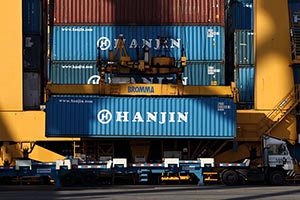Drayage Firms Look for Answers in Wake of Hanjin Shipping Bankruptcy

Trucking companies are scrambling to find answers in the wake of the Hanjin Shipping bankruptcy potentially saddling motor carriers with unreimbursed costs of $100,000 or more.
Companies providing drayage services want to know whether they can pick up containers at ports and who will pay them, if not Hanjin. There are also companies with outstanding debts with Hanjin for previous drayage work that could be written off as a loss.
“This is an extremely disruptive situation for all parties in the international supply chain and reaffirms why it is extremely important to do business with companies that are financially stable, despite very appealing pricing,” said Ken Kallaway, president of RoadOne IntermodaLogistics, based-in Randolph, Massachusetts, which ranks No. 8 on the Transport Topics list of top carriers in the intermodal and drayage sector.
RELATED: Truckers face wide-ranging challenges from stranded Hanjin freight
The Hanjin Greece, which holds 10,100 industry-standard 20-foot equivalent containers, or TEUs, is anchored off the coast near San Diego waiting for further instruction on when, or if, they can call the Port of Los Angeles. Golden State Logistics, a drayage company that serves both Los Angeles and nearby Long Beach, has containers on the vessel.
“We’ll deal with it when it arrives in port, but as I understand it right now, the port and the bankruptcy court are negotiating the issue,” said Fred Johring, president of Golden State Logistics. His company has five customers who routinely use Hanjin Shipping, but he adds that it’s not a significant portion of his business.
Drayage providers are also concerned that if they pick up Hanjin containers already at port, what do they do with the empty containers after delivery because the terminals won’t take them back now.
“In every case, so far, we’ve made arrangements with the consignees to store the empties at a place of their choosing until we can find a final resting place for it,” Johring said. “They understand that there’s going to be additional costs involved, especially as it relates to the chassis, since Hanjin is not paying for them now.”
Dave Manning, president of TCW Inc., which is based in Nashville, Tennessee, tells TT that he has one large customer that uses Hanjin. He said the customer, which he wouldn’t name, has agreed to pay his company to store containers.
However, in some cases, drayage companies already delivered the items before Hanjin went under and now cannot return the empty containers or charge the customer. For example, RoadOne has hundreds of empty containers and chassis accruing fees.
“Empty containers that we cannot return to a port, but that are sitting on neutral chassis are going to be charged to us for storage at up to $25 per day for the chassis, until they are returned to the pool provider or owner,” Kellaway said.
T.G.S. Transportation Inc., based-in Fresno, California, has about five empty containers that they cannot unload.
“Hanjin’s terminal in L.A.-Long Beach, Total Terminals, has ceased taking the boxes, as have all other terminals I’ve seen in Oakland, L.A. and Long Beach. So right now we’re just waiting to get more information,” said Peter Schneider, vice president at T.G.S.
Golden State Logistics lucked out and offloaded all but one container at the Pacific Container Terminal in Long Beach by redirecting his trucks to the task before it was too late, according to Johring.
The financial impact can range into the five or six figures when all the costs are added up. Some companies are still owed back pay from Hanjin for previous store-door deliveries, or shipments in which the ocean carrier pays the terminal and the drayage truck for their services, rather than a freight forwarder or beneficial cargo owner, or BCO.
Hanjin owes RoadOne hundreds of thousands of dollars, about $100,000 to TCW and tens of thousands to Golden State Logistics, according to the executives. Smaller companies could go under, adds Schneider, because some of them rely heavily on just one ocean carrier for business.
There also are ripple effects on the export side. Filled containers will not be accepted at port or on a vessel and it means the drayage companies have to empty the containers, find a new ocean carrier, then put the cargo into a new container and take it to port.
“I’m being asked to help on a number of exporters where they have already turned the loads into the terminal and are having to take them out now,” Johring said. “One of my customers had more than 27 loads to transfer, and other trucking companies in the state are getting similar calls.”
With all these unanswered questions, some companies are calling their trucking associations looking for guidance and assistance.
The California Trucking Association and the Harbor Trucking Association have been receiving calls since the news broke and are trying to reach port authorities and terminal operators in Los Angeles, Long Beach and Oakland to get information to pass back to their members.
Weston LaBar, executive director of the Harbor Trucking Association of Southern California, believes the ripple effects go beyond unpaid bills and empty containers.
“The trucking companies always get stuck in the middle because they are the front-line soldiers. It’s not unique, but that is definitely what is going on right now, truckers are being caught in the middle,” he said.

